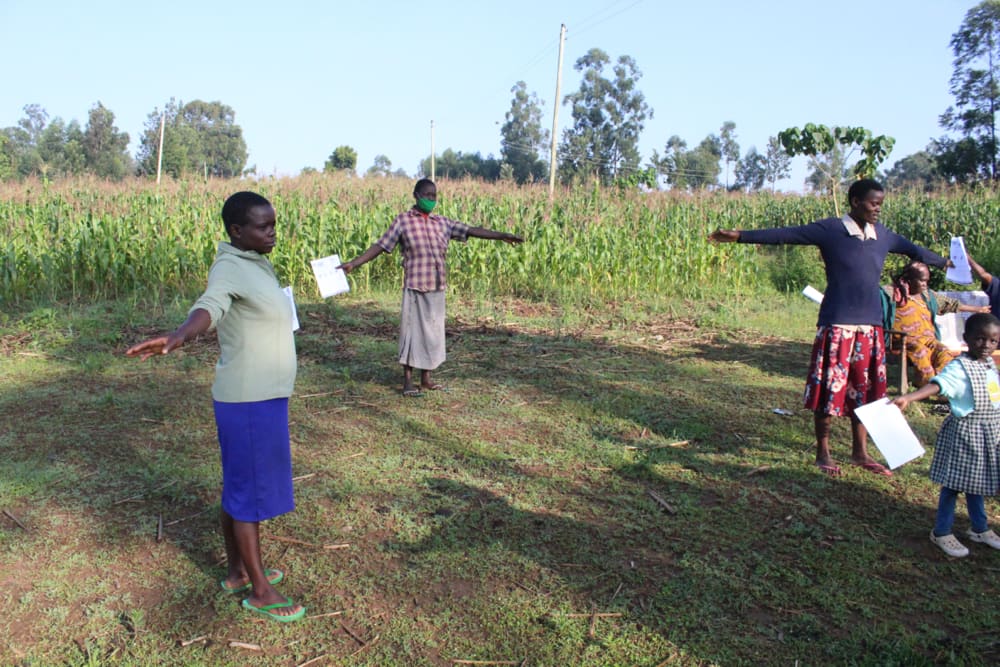This project is a part of our shared program with Western Water and Sanitation Forum (WEWASAFO). Our team is pleased to directly share the below report (edited for clarity, as needed).
Welcome to the Community
Emusanda Village is inhabited by the Wanga people of the Luhya Tribe.
A typical day begins with the adults going off to work. Farming is the main occupation here, with sugarcane planted as the main cash crop. Most people earn income from selling their sugarcane to a sugar factory 15 kilometers away from the village. Maize, groundnuts and beans are also grown as food for the family. In addition, some villagers have ventured into making their own bricks to sell for construction projects in the area.
Water Situation
Walusia Spring serves a community of 1260 people. (Editor's Note: While this many people may have access on any given day, realistically a single water source can only support a population of 350-500 people. To learn more, click here.) Walusia is an unprotected spring, meaning it is contaminated by surface runoff, open defecation and erosion. The water could be treated by boiling or with chemicals, but these are expensive and time-consuming for these farming families living in Emusanda. Many community members cannot afford either of these water treatment methods, and must drink the contaminated water raw.
Because the spring serves so many people, there is often quite a line to collect water! To avoid congestion and wasting a lot of time, many opt to get water at odd hours - around 4am or 8pm (while it is dark) which is risky, especially for women.
The people of the village have placed a small iron sheet directly where the water flows, making it easier for them to draw water. Instead of dunking containers into the muddy pool, people just need to hold their container under the sheet.
Most people in Emusanda have suffered from waterborne diseases such as typhoid, diarrhea and amoebiasis. "We have a problem with water," reports Angelia Shisia, a village elder. "I have spent most of my time and money in the hospital to treat my grandchildren who have been having diarrhea."
Sanitation Situation
A surprising number of households here have pit latrines - around 75%. The floor and walls are constructed of mud and the roof is an iron sheet. They are often rickety structures that offer little privacy, but fortunately they give families a proper place to dispose of waste. Unfortunately, 25% of a population over 1,000 means there are still a lot of community members practicing open defecation, meaning they relieve themselves in bushes or fields. This endangers the rest of the community, as feces can be spread by animals, insects, and rainwater.
Nobody has a hand-washing station, but most households have dish racks and clotheslines. Garbage is thrown into a pit or burned in an "out-of-the-way" place.
Plans: Hygiene and Sanitation Training
Community members enthusiastically look forward to participation in the two-day hygiene and sanitation training. This training will ensure participants are no longer ignorant about healthy practices and their importance in cleanliness and good health.
The facilitator plans to use PHAST (Participatory Hygiene and Sanitation Transformation), CLTS (Community-Led Total Sanitation) and ABCD (Asset-Based Community Development), group discussions, handouts and demonstrations at the spring.
Training will also result in the formation of a committee that will oversee operations and maintenance at the spring. They will enforce proper behavior around the spring and delegate tasks that will help preserve the site, such as building a fence and digging proper drainage.
Plans: Sanitation Platforms
The community will select five of its families for the new latrine platforms. They will be located next to the spring and will be families who are needy or do not have good toilets. The families must prepare by digging a pit over which the sanitation platforms will be placed.
Plans: Spring Protection
"Thank you so much for coming to our community. Indeed, God has remembered us," said Wellington Muyemba. "We just wish you can come and start protecting the spring for us tomorrow. This water has been the same since my childhood up to now. I have a family - almost getting grandchildren and no one has ever had a heart of helping us. We are glad that you have come and so as a community we promise to cooperate and give the necessary support to see the spring protected."
The community in will provide local materials such as sand and bricks, and neighbors to the spring will provide accommodation and food for the work team. A number of people will participate directly by providing unskilled labor in fencing the spring, planting the grass around the spring, supervising construction work and monitoring the progress.
Construction will keep surface runoff and other contaminants out of the water.
Protecting the spring will ensure that the water discharged from its pipe is clean and secure with an increased flow rate. Less waiting - more time for work and education. Less sickness - more energy to develop skills and interests. Just consider the possibilities! The folks in Emusanda are now doing just that!



 Rehabilitation Project
Rehabilitation Project







































